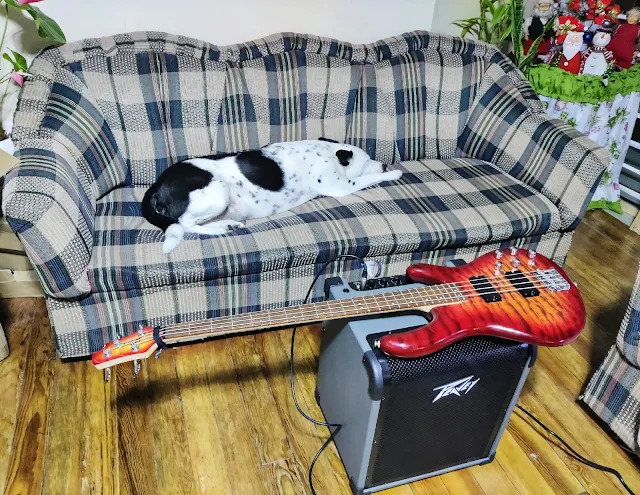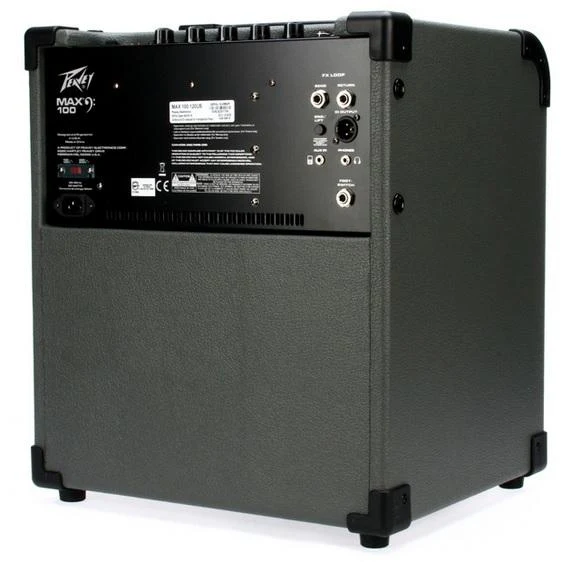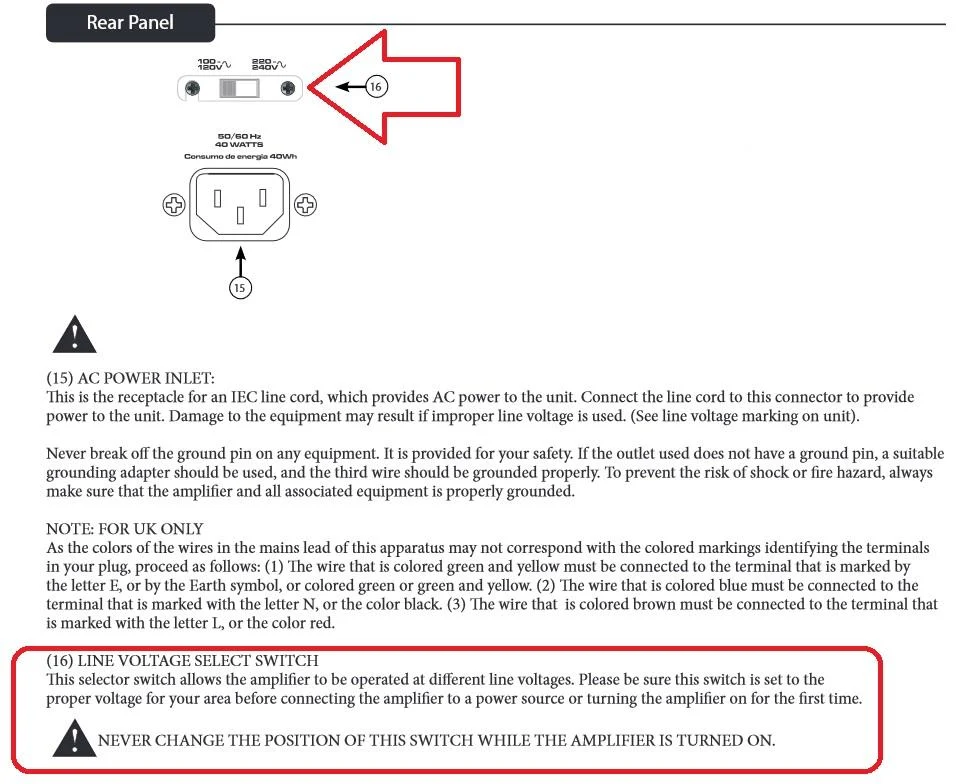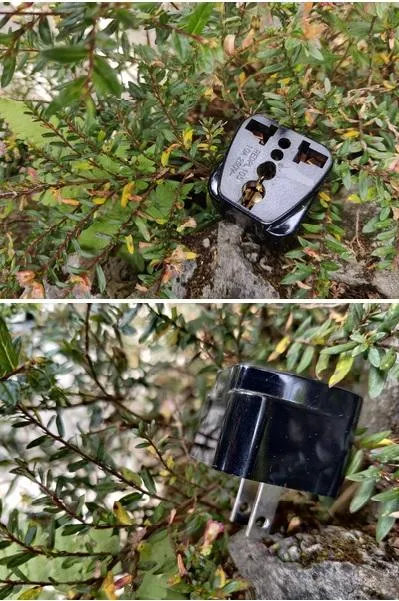Product Review:
My
Peavey Max 100 Bass Amp Combo
(17 Reasons why to own a
Peavey MAX 100)
Disclaimer: Before we begin, this review is highly my own personal perspective/
viewpoint, and/or direct playing experience in stress-testing a Peavey
MAX 100 bass amplifier.
This is NOT a paid endorsement/review by Peavey.
I started playing bass guitar around fourth year high school. However, I never owned a bass amp combo not until this blog post/review.
Most of the time, whenever I was doing sessions at concert venues (gyms, clubs, outdoor, et cetera), whatever bass amplifier that is there is what I use.
For daily practice at home, I relied with custom/bespoke bass amp with DIY speaker bass cabinet.
Now for newness reasons, and before the year comes to a close, I decided on the 12 December 2021 to put all of this (temporary) use case to finally rest.
So, I decided to buy my own personal brand-new bass amp combo.
Rewind, three days ago, as I did made my "assignment" or "due diligence" of which bass amp cum speaker combo to settle with, and considering financial resources of course, one that does not break the bank).
Fast forward, I ended up to online specs comparative site.
For illustrative/comparative purposes, below is the Peavey MAX 100 and a Blackstar Unity Bass U60 side by side.
In a nutshell, here's where the points hit its marks:
Darkstar U60 Peavey MAX 100
220 volts -- 1 point
Price Point -- 1 point (saved USD$100)
Compressor 1 point --
& Chorus switches
Send & Receive Ports -- 1 point
watts -- 60 watts 1 point (100 watts)
Chromatic Tuner -- 1 point
With the Blackstar U60, I was kind of stuck to only 110 volts power settings, which is not readily available (where I live).
Furthermore, 110 amps requires one to purchase a separe step up transformer for 110 to 220 volts. (Extra added cost.)
Also, having an option to adjust your power amp's voltage is too cumbersome, and will be too bothersome.
Also, this becomes some sort of a "ticking time bomb" since when one is not aware, the amp might might get accidentally plugged in a 220 volts line, and thus, frying this bass amp for good.
To eliminate this man-made accident/event, Peavey MAX 100 has a switchable voltage selector feature to adjust from 110 (default) to 220 volts, which is the magic key.
So, one point for Peavey, and no point to Blackstar U60 on voltage selection.
Also, the Blackstar U60 was USD $100 more expensive than the Peavey Max 100, and absent an effects loop (send and return) thus, I will not be able to optimize my multi-FX floor pedal effects.
So, I gave one point to the Peavey MAX on the clear price point benefit.
Above is a Video link of a Peavey MAX 100 in action.
Now, after some "rigorous" rounds, and coupled with burning the www comparing specs, costs, source/suppliers of bass combo amps, I ended up purchasing out of the pocket money, and also thus, eventually saving me $100.00.
PEAVEY MAX 100
Before the horse runs ahead of the carriage, here's an unboxing of my brand-new bass amp combo.
(On the image below is my brand new CORT Action DLX Plus active-passive bass, which I used to stress test the brand new Peavey MAX 100).
Note: Practice only when the dog is not sleeping. Do not disturb the groove. )
It was an auspicious day that my bass amp arrived simultaneously with an ongoing national online 12.12 sale where I live on this part of our earth.
In my humble opinion, I guess it's a good idea not to buy during sale days.
During sale days drives high demand/purchasing online and queuing.
In effect, one will be receiving
the ordered package/product arriving at your doorsteps at a much
latter date.
National online sales (Black Friday, et cetera) burdens all carriers/shippers since they will be swamped with lots of delivery/ fulfillment orders to farm-out to customers.
National online sales (Black Friday, et cetera) burdens all carriers/shippers since they will be swamped with lots of delivery/ fulfillment orders to farm-out to customers.
REVIEW PROPER
PRICE
(Is the price worth the package?)Answer - YES!
It's really a bang for the buck.
It's really a bang for the buck.
As of writing, I already saved like, around
$USD 100.00 for this local deal/purchase as a result of doing a "due
diligence".
AESTHETICS
(How does it look?)
Dimensions: (Height x Width x D)
Max 100 – 18.0” x 15.7” x 13.2”
Weight: 23.8 lbs. This is the total weight as pictured here which means, it is already out of the box without packaging materials total weight.
Max 100 – 18.0” x 15.7” x 13.2”
Weight: 23.8 lbs. This is the total weight as pictured here which means, it is already out of the box without packaging materials total weight.
Build:
Metal speaker grills - the PEAVEY MAX series comes with this unique feature which protects the 10 inches 8 ohm speaker from getting destroyed.
This is also a main consideration as Blackstar U60 combo bass amp does not sport a metal grill protective cover.
So, expect maximum protection from accidental bumps or objects coming into contact with the bass amp speaker.
Peavey Max activated "cloaking mode" of the Star Trek Entreprise.
Also, not a fingerprint magnet.
Electronics
SPECS:
POWER CONSUMPTION: (1/8 rated power, 1KHz sine wave) 120vac/60Hz, 230vac/50Hz
MAX 100 = 50 watts
POWER AMPLIFIER: (Rated Power)--Continuous RMS (1% THD, 1 KHz
sine wave, nominal line), The Peavey MAX 100 generates a maximum of 60 watts RMS (Root Mean Square) or continuous power into 8 ohms rated speakers.
Passive Input
=====================
=====================
Output Signal Level = Input Level – 10dB
AMPLIFIER: Maximum Input Sensitivity:
PRE GAIN = 10
LOW/MID/HIGH = 5,
VOLUME = 10, all voicing switches defeated
Passive Input
11mV / -36.95dBu 30mV / -28.24dBu 40mV / -25.74dBu
Active Input same as passive
Active Input same as passive
90mV / -18.70dBu 110mV / -16.95dBu
Auxiliary Input
420mV / -5.32dBu 900mV / 1.3dBu 1.0V / 2.22dBu
Nominal Input Sensitivity:
Auxiliary Input
420mV / -5.32dBu 900mV / 1.3dBu 1.0V / 2.22dBu
Nominal Input Sensitivity:
PRE GAIN = 5,
LOW/MID/HIGH = 5,
VOLUME = 5, all voicing switches defeated
Passive Input
LOW/MID/HIGH = 5,
VOLUME = 5, all voicing switches defeated
Passive Input
290mV / -8.53dBu 400mV / -5.74dBu 500mV / -3.8dBu
Active Input same as passive
Active Input same as passive
1.10V / 3.05dBu 1.40V / 5.14dBu
Auxiliary Input same as maximum
Auxiliary Input same as maximum
1.80V / 7.32dBu 2.10V / 8.66 dBu Headphone
Output: Mono or 50mW x 2 into 8-ohm minimum load
Output: Mono or 50mW x 2 into 8-ohm minimum load
=====================
Precision Balanced Direct Interface (DI):
(This feature I haven't yet tested)
This
XLR output is used to connect the Max preamp section to external
equipment, such as mixing consoles, external power amplifiers, or
recording equipment.
This
novel circuit provides a perfectly balanced and noise-free signal with
none of the problems associated with small transformers. =====================
Pre-EQ, unity buffer
Output Signal Level = Input Level – 10dB
Noise Floor = 0.95mV(RMS) = -78 BU
Before I begin the review process, let us proceed with the FIRST STEP WITH EXTREME CAUTION.
Below is the Peavey MAX 100's electric/power voltage selector switch.
Upon unpacking the unit out of the box, this is the FIRST THING that you will have to CHECK, before attempting to switching/powering on the bass amp.
In my situation, upon confirming, I slightly loosened the screws to release the protective transparent plastic cover, then set the desired power voltage from 100-120 volts to 220 - 240 volts.
Then I returned back
the plastic tamper guard then tightened back the screws.
FAILURE to set your correct electric power voltage will send your bass amp to its ultimate demise/destruction.
So, treat this caution with a sense of utmost urgency.
Again, DOUBLE CHECK your electric voltage in your area then set the power settings accordingly.
Always err on the side of safety.
I hope that PEAVEY will improve on this on all of its products and treat this as the first and foremost above everything else when producing it's printed paraphernalia/handouts/instruction manual, which come with the combo amp package/shipments.
When I was doing my due diligence, I only discovered the online PDF, and here is what it actually says.
On the image above is the actual Peavey MAX 100 U.K. electric power plug type, which comes with a built-in fuse (cool, eh!)
To make this work on my end, I bought a female plug adapter for this U.K. electric power plug type depicted below.
Absence of a COMPRESSOR:
The Peavey MAX 100 does not have a built-in compressor.
The Blackstar Unity 60 combo bass amp trumps Peavey MAX 100 on built in effects systems.
Blackstar Unity 60 comes with a compression switch (on/off) and Chorus switch (on/off)
**I solved this compressor inadequacy of the Peavey MAX 100 by using an ART BCC legacy multi-effects, which is a separate pedal board of mine represented in the succeeding images below.**
By the way, I posted this on my Reddit.
This is the ART (Applied Research and Technology) Bass Command Center multi-effects board. Proudly, made in U.S.A.
Factoid:
Did you know that Bernard "Bunny" Brunel helped ART
develop the features and sounds of the ART Bass Command Center (BCC).
develop the features and sounds of the ART Bass Command Center (BCC).
I will discuss the ART BCC review in a separate blog post.
CONS (Weakness) of Peavey MAX 100 (continuation)
So, this prompted me to look at how vulnerable the combo amp as seepage of any can penetrate the innards of the bass amp via the jack input ports (active/passive).
Avoid putting any containers containing liquid (e.g., coffee cups, softdrink bottles, cans, et cetera) on top of the bass top to prevent electrical shorting/grounding/equipment failure/destruction.
Avoid putting any containers containing liquid (e.g., coffee cups, softdrink bottles, cans, et cetera) on top of the bass top to prevent electrical shorting/grounding/equipment failure/destruction.
Versatility
+++++++++++
What are the PLUS-es:
Dedicated Active and Passive Inputs -Yup! All works fine.
Bass Guitar Peavey Max 100
Passive Amp Input Active Amp Input
Passive engaged Yup! Yup!
Active engaged Yup! Yup!
Passive BG through PA (standard/no brainer)
Passive BG through AA Yup! Works and no problem.
Active BG through PA Yup! Works and no problem.
Active BG through AA EXTREME POWER!!!!!
Built-in bass-specific chromatic tuner - in case I forgot to bring my portable battery-powered tuner. This becomes a gig-proof must.
1 x XLR (direct out)
- Ultra-quiet in paper. However, I haven't test this feature yet.
Now, this will also serve a
lot of help with facilitating external connections. E.g., via desktop PC
through DAW and/or DI box, yadah, yadah.
Angled Baffle speaker design - Designed by musicians working at Peavey for musicians in mind.
The
the bass amp is always coupled on the floor, and angled baffle directs
the sound up to the bass player's ears and not directed to one's
legs/foot.
Thus, one can hear the bass sound clearly. No need for tilt
back of the cab.
The MAX 100's angled baffle design directs your sound right where you need it, while its lightweight construction and efficient power amp ensure maximum portability.
The MAX 100's angled baffle design directs your sound right where you need it, while its lightweight construction and efficient power amp ensure maximum portability.
Clip-limiting DDT - this feature tames your dynamics, and
protects your speakers. This is probably one of the most important features for life-long use/operation of the bass amp.
Ground Lift -
eliminates grounding sound issues/protects you especially when the
floor/area is wet/damp when playing. No electrocution hazards, but
safety and clean sound output.
Send and receive ports plus (pedal port) - it's a breeze integrating my outboard floor processors.
Lightweight and Portability - can fit at the back of a cab/car and, won't break your spine. It is 11 kilos (lighter than an adult bicycle).
Standard IEC AC cable - and it's 120/220 volt-flexible choice. The,
Sound
(How does it sound?)
(How does it sound?)
The Peavey MAX 100's feature-rich design was tailor-made for performing bassists.
This 100-watt bass combo amp includes plenty of onboard sound
shaping, with a 3-band EQ and Overdrive, Contour, Mid Shift, and Bright
controls.
The Kosmos-C bass enhancement imparts harmonics and sub-harmonics
for maximum impact and tone. I pesonally love this setting.
Integrating your pedals and external processors
is a breeze, thanks to the MAX 100's effects loop.
TUNE/MUTE - Pressing this button will engage the chromatic tuner while muting the output to the speaker.
The LED screen will indicate which note is being played while the red and green LEDs above the screen indicate whether the note is flat (red), sharp (red) or in tune (green).This switch also mutes the DI
The LED screen will indicate which note is being played while the red and green LEDs above the screen indicate whether the note is flat (red), sharp (red) or in tune (green).This switch also mutes the DI
FX LOOP -The effects loop consists of the SEND and RETURN jacks, which are used to patch external effects processors post EQ in the signal chain.
Connect the SEND jack to the input of effects processors.
Connect the RETURN jack to the output of effects processors.
The EFFECTS SEND and RETURN - jacks can also be used as a line level unbalanced preamp output and power amp input jacks, respectively.
FX LOOP -The effects loop consists of the SEND and RETURN jacks, which are used to patch external effects processors post EQ in the signal chain.
Connect the SEND jack to the input of effects processors.
Connect the RETURN jack to the output of effects processors.
The EFFECTS SEND and RETURN - jacks can also be used as a line level unbalanced preamp output and power amp input jacks, respectively.
ACTIVE/PASSIVE PICKUP jack inputs- These 1/4" inputs are included so you can choose the appropriate setting for your instrument. The gain structure of the amplifier is modified to accommodate the outputs of different pickup configurations.
The PASSIVE input is 10dB hotter than the ACTIVE input.
GAIN - This knob controls input level to the pre-amp.
OVERDRIVE - This crunch circuit is designed so that the volume of the amp will not change when the boost is switched on, but the distortion level will increase depending on the level of the GAIN knob. (I'm not a fan of this setting, so I leave it unswitched.)
For best results, first set the distortion amount by adjusting the GAIN. Next, set the desired volume using the VOLUME knob.
OVERDRIVE - This crunch circuit is designed so that the volume of the amp will not change when the boost is switched on, but the distortion level will increase depending on the level of the GAIN knob. (I'm not a fan of this setting, so I leave it unswitched.)
For best results, first set the distortion amount by adjusting the GAIN. Next, set the desired volume using the VOLUME knob.
At this point, the clean
volume will match if the Overdrive is turned off.
BASS - This knob provides a shelving tone control for low frequencies and provides cut/boost of +/-15 dB. The center point is flat. The center frequency is 50 Hz. -3 dB shelf corner frequency is 100Hz.
CONTOUR - This button boosts highs and lows while simultaneously cutting mid tones, producing a "scooped" sound. (I love this setting).
MIDDLE - This knob provides a peaking tone control for Mid frequencies and cut/boost of +/-15dB. The center point is flat.
BASS - This knob provides a shelving tone control for low frequencies and provides cut/boost of +/-15 dB. The center point is flat. The center frequency is 50 Hz. -3 dB shelf corner frequency is 100Hz.
CONTOUR - This button boosts highs and lows while simultaneously cutting mid tones, producing a "scooped" sound. (I love this setting).
MIDDLE - This knob provides a peaking tone control for Mid frequencies and cut/boost of +/-15dB. The center point is flat.
MID SHIFT - This switch controls the center frequency of the MIDDLE knob. When the switch is OUT, the middle frequency is 600Hz.
The middle frequency is 250Hz when the switch is pushed IN. (I left this in the middle position since my CORT Action DLX Plus bass has active EQ)
TREBLE - This knob provides a shelving tone control for high frequencies and cut/boost of +/-15dB. The center point is flat and the frequency is 6 KHz. -3dB; the shelf corner frequency is 4 KHz. (I kept the setting in the middle position).
BRIGHT SWITCH - This button provides a 10 dB boost to frequencies above 1KHz. To activate, depress the switch to its “IN” position. (I kept the setting in the middle position).
VOLUME - This knob controls the overall volume of the amplifier.
KOSMOS-C Subharmonic Generator - This Kosmos-C Low enhancement works by creating harmonics of signals in the bottom octave, where speakers are usually ineffective.
The
harmonics are more easily reproduced, resulting in a perception of
stronger bass.
(I plan in the future to fully maximize the use of this
feature via XLR out through a separate active sub-woofer speaker capable of handling subharmonics).
The effect is source dependent; obviously a source with little energy in the bottom octave will not create booming bass.
The effect is source dependent; obviously a source with little energy in the bottom octave will not create booming bass.
CONCLUSION:
For this product review. In my experience, the Peavey MAX 100 bass combo is a sure winner.
1. Flexible 110 - 220 voltage setting
2. Price Point (USD$ 100 savings)!
3. Send & Receive Effects loop/Port
4. Built in Chromatic Tuner (with mute/tune)
5. Metal Grill amp/speaker enclosure
6. Angled Baffle Speaker design
7. Lightweight (23.8 lbs.) and portability (width 15.7") (depth 13.2")
9. Ground Lift Protection
10. Clip Limiting DDT (Speaker protection)
11. XLR (one direct out)
12. Amp
Watts 100 watts 60 RMS
electric power consumption: 50 watts
13. Aux in (for interfacing MP3 player/music for )
14. Foot switch input/output 1 x x/4 inches
15. Headphone 1 x 1/8 inch input
16. 3 band eq (Overdrive, Contour, Mid Shift, and Bright with separate Kosmos Sub-harmonic generator)
17. Active and Passive bass inputs
1. Flexible 110 - 220 voltage setting
2. Price Point (USD$ 100 savings)!
3. Send & Receive Effects loop/Port
4. Built in Chromatic Tuner (with mute/tune)
5. Metal Grill amp/speaker enclosure
6. Angled Baffle Speaker design
7. Lightweight (23.8 lbs.) and portability (width 15.7") (depth 13.2")
9. Ground Lift Protection
10. Clip Limiting DDT (Speaker protection)
11. XLR (one direct out)
12. Amp
Watts 100 watts 60 RMS
electric power consumption: 50 watts
13. Aux in (for interfacing MP3 player/music for )
14. Foot switch input/output 1 x x/4 inches
15. Headphone 1 x 1/8 inch input
16. 3 band eq (Overdrive, Contour, Mid Shift, and Bright with separate Kosmos Sub-harmonic generator)
17. Active and Passive bass inputs
18. Controls (Bass, Treble, Middle, Gain, and Volume)
I will also do a video documentation of how I use the Peavey MAX 100 with the ART Bass Command Center which is coming soon!



























Post Comment
Post a Comment